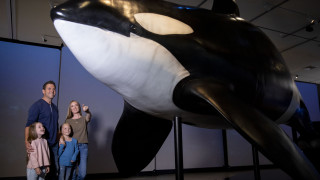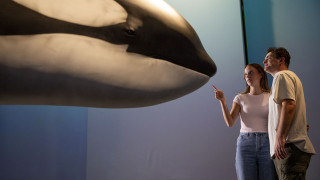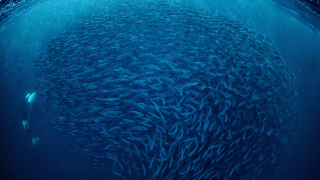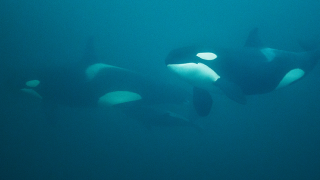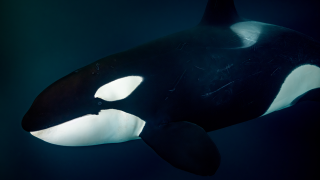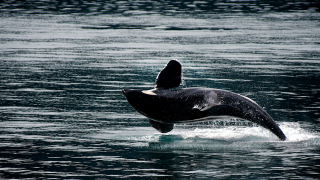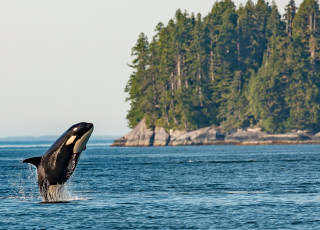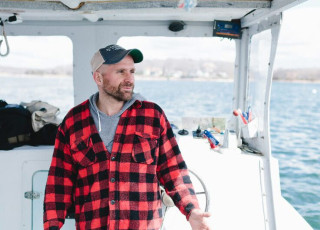Orcas and Humans: Five Surprising Similarities
By Olivia Barney

A father and daughter admire a wooden Orca skeleton at NHMU. Photo by Jack Rodgers
From a superficial view, orcas and humans could not appear more different. But if you dive in and look at things beneath the surface, you’d be shocked to discover how similar we are. Orcas are the apex predators of the sea, so if humans rule the land, orcas might just rule the oceans. Curious about our underwater cousins? Check out five astonishing things orcas and humans have in common — then take your learning to the next level by visiting Orcas: Our Shared Future, a special exhibition on display at NHMU through April 20, 2025.
1. Social Dynamics
If you’ve seen an orca in captivity, you might think that they’re solitary animals — lone hunters of the sea. But this couldn’t be further from the truth. In the unconfined ocean waters, orcas belong to communities, families that rely on one another for survival. These groups interact and govern themselves the way families within your neighborhood might.
Orcas organize themselves into a social structure that humans can relate to. Individuals unite as a family unit (called a pod). Similar pods occupy the same areas and occasionally interact, joining together for a larger hunt or to mate. Orcas in different areas, or those that belong to a group that has adapted to their environment in a unique way (ecotype), do not unite under a common goal or mate across ecotypes.
On a familial level, orcas share with humans a loyalty to their relatives. Each pod is governed by the oldest (and therefore wisest) matriarch. These grandmothers are responsible for leading the pod in hunting efforts, passing down traditions, and helping to raise the young. As recent research has explored the personalities and emotional capacity of orcas, scientists have discovered how these pods celebrate and mourn as families. As a result, severing ties between an orca and their pod impacts physical and mental wellbeing. Orcas need each other the way humans do.
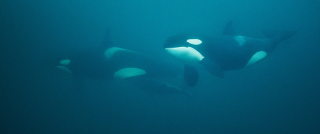
Orca Pair Swimming Underwater Adobe Stock Image
2. Unique Languages
If you travel the world, you’ll encounter groups of people who speak languages that are unfamiliar to you. You might also encounter people who share your language, but, because of accents or regional dialects, they still sound somewhat foreign to you. Language and dialects play important roles in the identity and history of a culture, and not just for humans! Orcas around the world communicate with each other in distinct languages — unique enough to sound foreign to other orca pods.
Orcas make three kinds of vocalizations: clicks, whistles, and discrete calls. Clicks are short sounds that play a key role in an orca’s survival. They’re used in a navigational technique called echolocation, which uses sound waves to determine direction, distance, and the presence of other nearby life. Clicks emit sound waves that bounce off (echo) any surrounding obstacles or animals. This is especially important for orcas because they don’t have great eyesight. The reverberating sound waves from clicks help them to navigate the vast, dark ocean.

Family of Orcas Swimming
The second and third sounds, whistles and discrete calls, are used for socializing and communicating with other members of the pod. They can sound like a high-pitched cry or melancholy song. To an untrained ear, most of these calls sound the same. But to the orcas within the pod, they are clear messages: coordinating hunts, greeting one another, and warning of potential dangers. These calls are taught through generations, developing distinguishable dialects between family groups.
3. Favorite Foods
A person’s location, lifestyle, and access to ingredients influence their diet. Family recipes, particularly those associated with beloved traditions or memories, also influence an individual’s choice of favorite foods. This is as universal to humans as it is to orcas.
Orcas around the world have dietary preferences unique to their pods and demonstrate a remarkable unwillingness to switch up their diet. This resistance to change, however, doesn’t stem from pickiness — it’s a matter of experience. An orca pod’s diet is determined by both location and hunting tactics. Orca diets around the world vary from fish, seal, shark liver, squid, and even large whales. The chosen food source depends on location (for example, penguins are usually only found near cold water in the southern hemisphere).
But hunting tactics also make a difference. In the Pacific Northwest, Resident and Transient (or Bigg’s) orcas occupy the same waters, and therefore, have access to the same resources. And yet, their diets are completely distinct. Resident orcas primarily eat fish (most often salmon), while Transients feast on squid and marine mammals (such as seals). These preferences come, in part, due to the hunting tactics each pod has learned. Both diets require specialized hunting techniques, and because those techniques have been taught through generations, most pods do not vary in their approach.

Orca Hunting Fish Adobe Stock Image
4. Menopause
It is extremely uncommon for female members of a species to go through menopause. Aside from humans, only four
other species have been proven to experience this developmental phenomenon: narwhals, belugas, short-finned pilot whales, and orcas. Though this discovery initially left researchers puzzled, a new theory called “the Grandmother Hypothesis” could explain why orcas experience menopause.

Solo Orca Swimming Adobe Stock Image
Female orcas live much longer than their male counterparts (with females living up to 90 years and males living up to 60). As a result, Orcas live as social creatures in a matriarchal society. Their pods are led by female authority, and typically that authority is passed from mothers to daughters. Grandmothers help care for their grandchildren while also leading the pod’s hunting efforts.
The oldest female in each pod carries a responsibility to teach the younger orcas how and where to hunt, which locations they should call home, and how to identify potential dangers. Menopause allows female orcas to live longer, assist in raising the young, and communicate the cultural elements that distinguish their pod from others.
5. Cultural Traditions
People around the world participate in traditions that have been passed down through generations. The way we celebrate holidays, for example, is different around the world. Even within our local communities, each family celebrates uniquely — with foods, activities, and stories that are significant to them. The development of these cultures is a key part of the evolutionary process.
Until recently, researchers have found little evidence to suggest that anything besides humans evolved in the same way. In recent years, however, scientists at the University of Bern, Switzerland conducted research that led to a breakthrough discovery: the evolution of orcas relies on evolution. This discovery is significant because it marks the first time a non-human species has been linked to a cultural evolution.
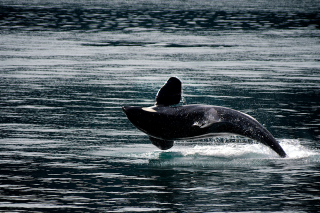
Full Breach by Orca
Orcas are found in every ocean across the globe, making them almost as widely dispersed as humans. That dispersion has significance. Orcas around the world may look identical to the untrained eye, but each pod is unique in their diet, behavior, and hunting techniques. These attributes are passed down through generations: grandmothers teach their posterity, and the communication of this cultural information is necessary for the pod’s continued survival.
There’s so much about orcas that is yet to be discovered and understood, but research efforts are sometimes squandered by the myths and misconceptions surrounding the unfairly named “killer whales.” Find out the truth about orcas by visiting NHMU’s newest special exhibition, Orcas: Our Shared Future.
Orcas is on display through April 20, 2025. Access to the show is included with regular museum admission, which is free for Museum Members.
1 of 10


